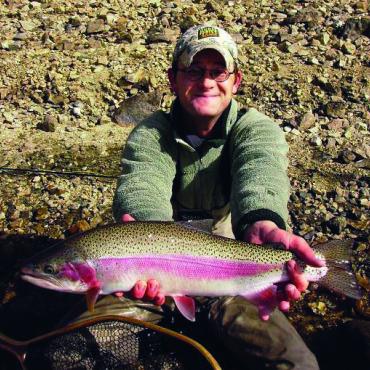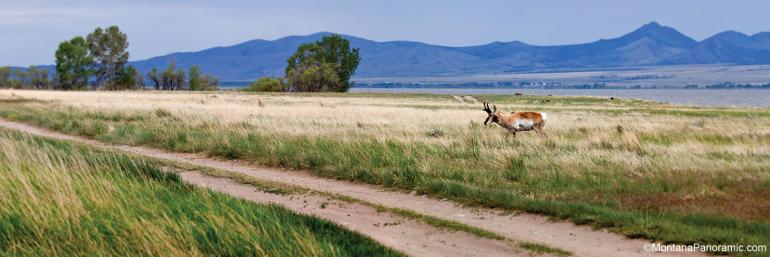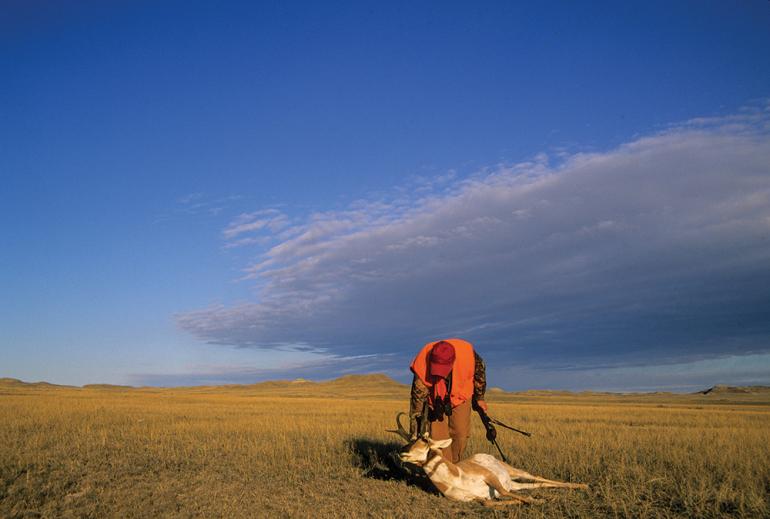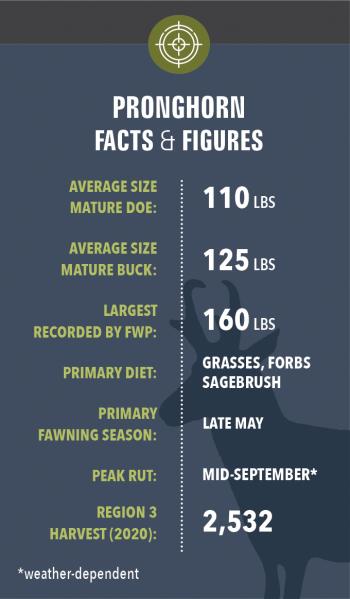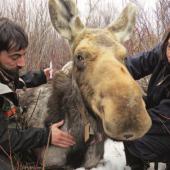Speedelicious
Hunting Montana's fastest ungulate.
I’ve often been asked, “If you could only hunt one big game animal for the rest of your life, which one would it be?” For a serious and committed western big game hunter, this question is akin to asking a mother which one of her kids she loves the most. However, when it comes to hunting, if I had to pick a favorite, it would definitely be the pronghorn antelope. My reasoning is simple. Pronghorn, or Antilocapra americana, tend to live in sparsely populated, arid, hard, wide-open country, and provided proper care is taken in the field, their meat is some of the best-tasting of any game species. A holdover from the Pleistocene era, pronghorn evolved to outrun a long-extinct, saber-toothed, cheetah-like cat. Antelope, as we commonly call them, can run at speeds in excess of 50 miles per hour, and their superior eyesight and hearing empower them to utilize even the slightest variation in topography, making them incredibly difficult to stalk. Simply put, antelope are my favorite prey because pursuing them makes me a better hunter.
Habitat
Any open patch of prairie or sagebrush flat east of the Continental Divide in Montana is likely to provide habitat for pronghorn. There are likewise several areas of similar habitat west of the divide and down the Columbia drainage into Idaho, Oregon, and eastern Washington. Antelope are evolved for the high plains and prairie in which they live. While it is increasingly rare to find uninterrupted tall-grass prairie habitat, the pronghorn has done a remarkable job of adapting to agriculture, oftentimes utilizing wheat and alfalfa fields to supplement its native-grass diet. Areas where these two habitat types intersect are ideal locations to scout.
Behavior & Rut
As with any big-game species, understanding the year-round behavior of both sexes of antelope is critical to hunting success. As a general rule, pronghorns are migratory, they tend to move seasonally, following ancient routes in search of quality forage. During warmer months, herd size is usually small—three to ten individuals. In the winter, as grazing resources become scarce, herd sizes are much larger. Feeding antelope are constantly on the move, and even when unstressed, it is not uncommon for herds to appear and moments later disappear behind a slight rise or into a shallow coulee. When pressured or spooked, antelope will explode in a blast of speed, rapidly eating up miles and putting distance between themselves and the perceived threat.
Mature male pronghorn have horns, and about a third of females do as well. The antelope horn is a true horn, meaning it is made of keratin, unlike antlers, which are made of bone. One thing that makes antelope unique among horned animals is that the horn branches, forming a “prong.” Males also have a black patch of hair that runs down the backside of the jawbone. This hair is remarkably like a sideburn, and the bigger the sideburns, the better the buck.
During the spring, younger males, those with the puny sideburns, will form bachelor groups. Females will tend to stay together away from these “young bucks” and the older mature bucks will branch out even further, staying largely solitary. Come late August, these mature bucks will gather up those groups of does into harems and aggressively defend them. As with elk and deer, rutting males become more focused on breeding than self-preservation. In Montana, we are fortunate enough to have the opportunity to archery-hunt during this period. Many hunters will utilize decoys during this time to draw bucks into range. The antelope rut is usually over by mid-September; however, bucks will tend to stick with their does well into autumn. One theory behind this is that the extra sets of eyes and ears allow bucks to rest and recover from the stresses of the rut.
Just like elk and deer, antelope are at their most active during the pre-dawn and twilight hours. They do not, however, seek cover to bed down during mid-day. Using their extraordinary eyesight, hearing, and olfactory senses, pronghorn find security and safety in the great wide open. The best way to hunt them is to glass resting herds from a great distance and study the topography. Locate a favorable approach, plan your stalk, and mind the wind.
Gear
Antelope are smaller than deer, which means that a more petite rifle cartridge can be effective in harvesting one. However, due to the wariness and speed of antelope, many hunters choose faster, flatter-shooting, long-range rounds for those moments when cover and concealment are not possible. Archery hunters will benefit greatly by dialing up the draw weight on their bows. A good solid punch will prevent your quarry from getting up to speed and disappearing into the next county. As always, never skimp on optics. Distances in antelope country are measured in miles. Good-quality binoculars, a spotting scope, and a rangefinder are all indispensable items that will keep one from wandering aimlessly on the prairie, hand to brow, squinting at white rumps bobbing away in the distance. Archery hunters should wear camo patterns that match the color and texture of the landscape. Many archery hunters will also utilize “brushed up” pop-up blinds around likely watering holes or other areas where game is likely to congregate.
Antelope season starts earlier than general deer and elk season. It can get hot. One of those high-dollar coolers big enough to hold a middle-school kid, is a solid piece of gear that will aid greatly in preserving that hard-won meat. Boots for pronghorn hunting should be light, highly breathable, and more like a sneaker or moccasin than a boot. When choosing a pack for antelope hunting, go light. Choose something that will carry enough water, snacks, and extra layers to make those long hours of glassing comfortable.
Pack-Out
Pronghorn antelope are the smallest of big-game animals; even the biggest of bucks can be slung over your shoulders for a triumphant trudge back to the truck. Considering that heat is a major factor during antelope season, dressing, boning, and quartering your animal in the field can be the key to ensuring tasty table fare post-hunt. Removing the hide and getting the meat off the bone helps considerably with cooling. Gear up for your hunt with a mind toward meals down the road. Before pulling the trigger or launching an arrow, make sure that you have a plan and a strategy for preserving your meat.
Regs
In Montana, archery season for antelope starts early—mid-August in many cases, for those lucky enough to draw special tags. General archery season begins in early September and depending upon the year can last four to five weeks. Rifle season for antelope begins in early October and lasts about four weeks. The deadline to apply for tags is June 1. In many hunting districts, those fortunate enough to draw a tag can also purchase additional doe/fawn tags. For more information, visit fwp.mt.gov.

